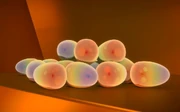A tardigrade was a type of alien first encountered in 2256. The species was so named because it shared some natural traits with the Earth species of the same name, which was described as its cousin. It was highly evolved with a highly functioning nervous system, and neurological tests suggested it might be sentient. (DIS: "Choose Your Pain")
It was a multi-dimensional creature whose unique genetic makeup allowed it to navigate the mycelial network by incorporating Prototaxites stellaviatori DNA in its genome through horizontal gene transfer. Its relation with P. stellaviatori was described as symbiotic. (DIS: "The Butcher's Knife Cares Not for the Lamb's Cry", "Choose Your Pain", "Magic to Make the Sanest Man Go Mad")
Although nothing in its biology suggested that it would attack except in self defense, when it did defend itself it was formidable. One member of the species killed a dozen Klingons and was found without a single bat'leth scratch afterwards. Its claws could shred the hull of a Starfleet ship, and its hide could withstand the firepower of a phaser set to kill. One weakness, however, was that the creature had a natural aversion to light. (DIS: "The Butcher's Knife Cares Not for the Lamb's Cry")

A display of the tardigrade and its brain
The tardigrade had a brain; micropatterns in the neurons of its frontopolar cortex formed a neuronal link, an internal transdimensional portal to other universes. (DIS: "The Wolf Inside")

Tardigrade eggs
Tardigrades were known by Starfleet Science to lay eggs with exceptionally long gestational periods. (ST: "Ephraim and Dot")
The creature was noted to be incredibly regenerative, and assessed as being virtually indestructible. When faced with adverse conditions, the creature could go into a state of extreme cryptobiosis as a survival mode. This reduced the water content of its body to less than one percent and slowed its vital signs to the point that they could barely be detected.
The first known tardigrade was called "Ripper", and was documented by the crew of the USS Discovery in 2256. It was discovered that through the tardigrade's connection to the mycelial network, it could be used as an organic computer to navigate the network and dramatically improve the performance of the experimental spore drive. After the Discovery made the spore drive viable by utilizing the tardigrade, Starfleet directed every ship, colony, and starbase to search for more tardigrades. However, forcing the creature to navigate the mycelial network would cause it great pain and progressively damage its frontal lobe. "Ripper" was subsequently released and the role of the organic "computer" was taken by the Discovery's chief engineer, Lieutenant Paul Stamets. (DIS: "Choose Your Pain")

The tardigrade Ephraim pursues the USS Enterprise
In 2267, a tardigrade known as Ephraim encountered the USS Enterprise and laid her eggs inside that ship's warp core. Ephraim, however, was repeatedly repelled from the ship by a DOT-7 called Dot, whose efforts to keep Ephraim away spanned over the course of the ship's history, ending in 2285 when the Enterprise self-destructed over the Genesis planet. Discovering Ephraim had laid her eggs aboard the ship, Dot was able to rescue the tardigrade's hatchlings and reunite them with their mother before the destruction of the Enterprise. (ST: "Ephraim and Dot")
In 3189, Stamets told Invigilator Aurellio that tardigrades were extinct. (DIS: "There Is A Tide...")
Since the disaster that struck the Glenn was said to have affected all "organics" on board, tardigrades may not qualify as such, although they had DNA.
Although this was not spelled out, the cryptobiosis state also mirrors that of Earth tardigrades, who in fact rely on it to survive in the extreme environments they are said to be able to withstand.
